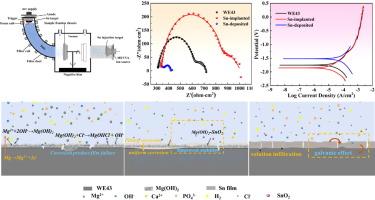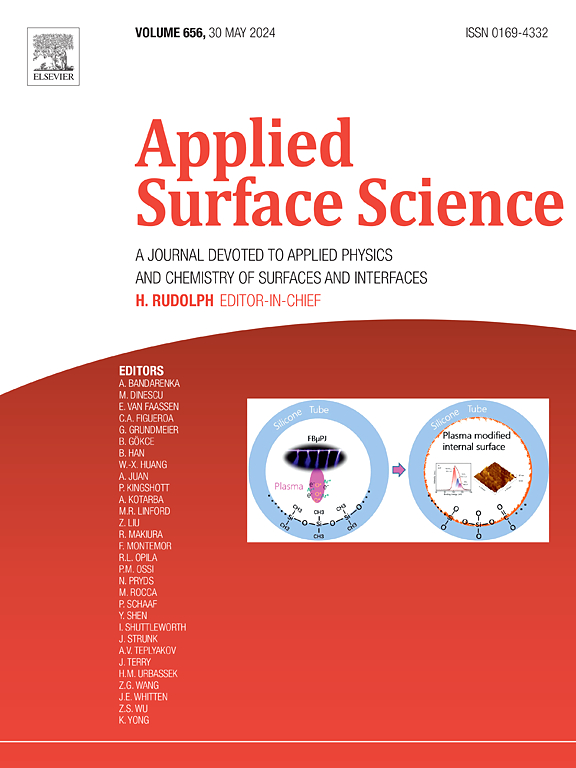通过等离子体参与工艺在镁合金表面形成的锡基改性涂层的不同腐蚀行为:FCVA 沉积与 MEVVA 离子注入
IF 6.3
2区 材料科学
Q2 CHEMISTRY, PHYSICAL
引用次数: 0
摘要
在这项工作中,使用具有过滤阴极真空电弧(FCVA)和金属蒸气真空电弧(MEVVA)功能的复合装置对 WE43 表面进行了锡离子改性。比较研究了不同处理方法改性后,锡离子对 WE43 表面形貌、弹性模量(EIT)、纳米硬度(HIT)和耐腐蚀性能的影响。还从腐蚀动力学和氧化过程的角度阐述了腐蚀机理。结果表明,采用 FCVA 和 MEVVA 两种方法对 WE43 进行 Sn 离子改性后,样品的弹性模量均有所提高,其中 FCVA 改性后的 EIT 从 55.24 GPa 提高到 57.04 GPa。FCVA 技术在样品表面覆盖了一层均匀的锡膜,但由于锡和镁之间的电位差过大,加剧了电偶腐蚀。注入 Sn 离子后,样品表面成功形成了由 SnO2 和 Sn 组成的改性层。经电化学测量,WE43、Sn 注入和 Sn 沉积的 Icorr 分别为 23.15、17.88 和 65.25 μA-cm-2。浸泡实验结果表明,二氧化锡有效地阻止了 Mg (OH)2 的溶解,从而形成了一层均匀致密的腐蚀产物膜,增强了 WE43 的耐腐蚀性。本文章由计算机程序翻译,如有差异,请以英文原文为准。

Different corrosion behaviors of Sn-based modification coatings on magnesium alloy surface via plasma-involved processes: FCVA deposition vs MEVVA ion implantation
In this work, the surface of WE43 was modified with Sn ions using a composite device with both filtered cathode vacuum arc (FCVA) and metal vapor vacuum arc (MEVVA) functions. The influences of Sn ions on the surface morphology, elasticity modulus (EIT), nano-hardness (HIT), and corrosion resistance of WE43 after modification by different treatments were comparatively studied. The corrosion mechanism was also elaborated from the perspectives of corrosion kinetics and oxidation process. The results proved that the modulus of elasticity of the samples increased after the Sn ion modification of WE43 by both FCVA and MEVVA, in which the EIT increased from 55.24 to 57.04 GPa after FCVA modification. The FCVA technique covered the surface of the samples with a uniform Sn film, however, the difference in potential between Sn and Mg was too large which aggravated the galvanic coupling corrosion. After the injection of Sn ions, a modified layer consisting of SnO2 and Sn was successfully formed on the sample face. The electrochemically measured Icorr of WE43, Sn-implanted and Sn-deposited were 23.15, 17.88 and 65.25 μA⋅cm−2. The results of the immersion experiments demonstrated that SnO2 effectively impeded the dissolution of Mg (OH)2, resulting in the formation of a uniform and dense corrosion product film that enhanced the corrosion resistance of WE43.
求助全文
通过发布文献求助,成功后即可免费获取论文全文。
去求助
来源期刊

Applied Surface Science
工程技术-材料科学:膜
CiteScore
12.50
自引率
7.50%
发文量
3393
审稿时长
67 days
期刊介绍:
Applied Surface Science covers topics contributing to a better understanding of surfaces, interfaces, nanostructures and their applications. The journal is concerned with scientific research on the atomic and molecular level of material properties determined with specific surface analytical techniques and/or computational methods, as well as the processing of such structures.
 求助内容:
求助内容: 应助结果提醒方式:
应助结果提醒方式:


